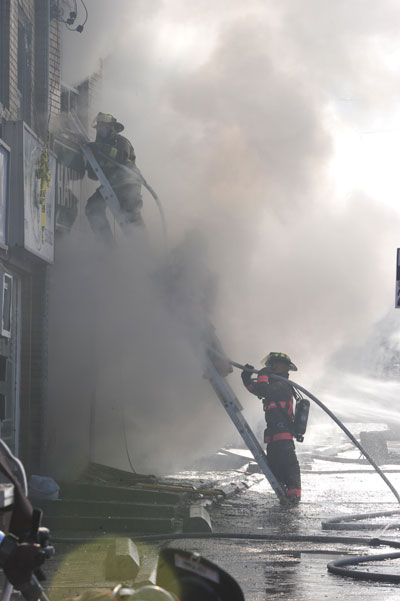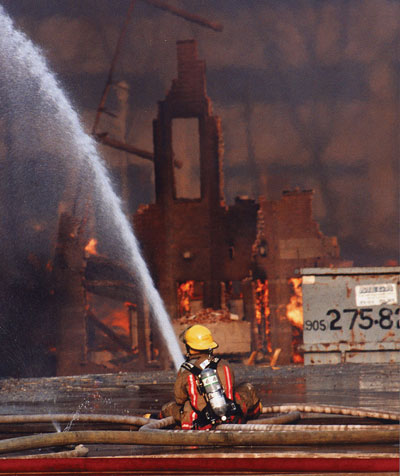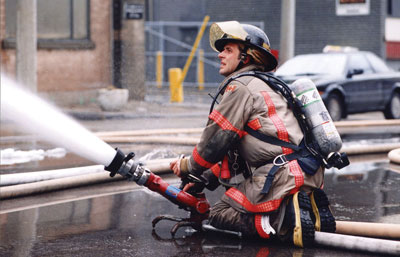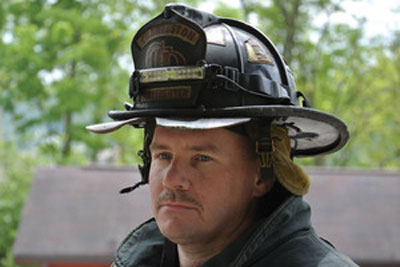
Features
Training
Fire-ground strategies
Other than protecting life, extinguishing fire is the top priority of firefighters at any fire call; this requires the responding engine, quint, ladder truck, or whatever water-carrying vehicle you have, in order to place hoselines into service and advance on the fire.
March 4, 2013
By Ryan Pennington
Other than protecting life, extinguishing fire is the top priority of firefighters at any fire call; this requires the responding engine, quint, ladder truck, or whatever water-carrying vehicle you have, in order to place hoselines into service and advance on the fire.
 |
|
| Photo by John Riddell
|
A crew of firefighters should looked like a well-oiled set of pistons firing in unison as we arrive, estimate, and carry out the fire attack. This task should be shared with all firefighters as we strive for the perfect stretch. Being the leader of a crew making the hoseline deployment can be difficult; our jobs as backwards-riding, street-level firefighters should be to lessen the load of the decision makers by having the knowledge and discipline to function under their command and make the stretch.
Let’s take a look at the five Ws of hoseline responsibility and how they are shared with the entire crew to put out the fire as quickly and efficiently as possible.
Who
With today’s staffing issues, the first W of hoseline operations – Who is responding to the fire? – is the most important. First-arriving crews should have an idea of the number of expected responding units and their training levels. Establishing the number of firefighters, apparatuses and supervisors can help firefighters select the appropriate hoselines.
 |
|
| The most important consideration in hoseline operations is to know who is responding and their training levels.
|
An officer needs to make crew assignments based on staffing levels and the abilities of the firefighters. For example, a 64 millimetre (two-and-one-half-inch) hoseline requires more technique and manpower to deploy and manoeuvre than a smaller hose. Choosing this option – rather than a more manageable 45 millimetre (one-and-three-quarter-inch) hoseline – with an inexperienced crew, could cause a delay in initial knockdown.
Firefighters also need to establish who will be deploying the first handline and understand what is expected of that firefighter. Officers should be specific in their direction: “Captain to firefighter: Pull the front crosslay and advance to the side C doorway and wait for me.” This will ensure that there is no question or confusion about the direction; it is the firefighter’s job to confirm that he or she has received this message and can perform the task that has been requested.
What
The what of hoseline deployment depends on many variables. From fire growth and spread, to the type of construction, everyone on the fire ground should understand which line is the most appropriate.
Chief John Smoot of Teays Valley, W.V., who repeated the famous line, “That fire doesn’t match that hose,” always comes to mind when discussing hoseline selection; the quote came from a firefighter on a second-arriving engine who noticed an “outgunned” first engine that was fighting a large, well-involved structure with the smaller, 45 millimetre (one-and-three-quarter-inch) attack line. There is a point at which the fire is too large to contain with these smaller lines; it’s our job to recognize and understand the point at which larger lines should be used.
When
When to deploy which hoseline can be complicated, depending on staffing and your type of response area. When is your second-due arriving and when is your water supply going to be established are two questions that should be answered before hoselines are selected. If you know your second due is just minutes behind, you may choose to proceed to the fire without laying out your supply line in order to make a quicker first attack, and to allow access for the truck company. This can narrow your choices of hoselines, as you will have a limited amount of water, depending on tank size.
Established response times of all companies should have been pre-planned for all areas in your district. When estimating arrival times, you should also account for variables such as apparatus accidents or road closures. Establishing good communication routes is key to determining when to select hoselines. Here’s an example of good communication in establishing when to lay hoeslines: “Engine 1 to Engine 2, we are going fast attack; please lay into Engine 1.” “Received, Engine 2, ETA of five minutes.”
Where
Now that we are on scene and we know who we have responding and when the next crew will be here, it’s time to attack the fire. Deciding where the first hoseline should be placed can be a complex decision with many variables. First and foremost, our job is to protect life. If we have received reports of people trapped, the first hoseline should go to protect escape routes. From stairwells to uninvolved rooms, placing the hoseline to hold back the fire will give occupants time to make their escape; this should be the first priority.
 |
|
| The what of hoseline deployment depends on everything from fire growth and spread to the type of construction. The larger the fire, the larger the hoseline should be.
|
Once crews have determined that there are no trapped occupants, it’s time to choose the attack point of entry. Advancing from the unburned side of the structure to the burned side has long been the accepted method, but a point of warning: today’s fires burn hotter due to the solidified petroleum products that produce a thicker, more flammable smoke. Advancing through this smoke should be done with caution as you continue to watch for the signs of flashover. Don’t be afraid to make a quick hit through a window or doorway to darken down the fire and reduce the chance of flashover. While this tactic has been controversial, it makes for a safer attack as crews are at less risk.
If you arrive to find a well-involved structure, the hoselines may need to go toward exposures. If the building of fire origin is beyond saving, it’s time to contain the fire to one building, not two or three. This option means firefighters can use larger, less maneuverable streams. Pulling the 64 millimetre (two-and-a-half-inch) hose can prove to be the best option due to the fire’s growth and the ability of one firefighter to place it into service and control it.
Why
Understanding why we do what we do is very important to this jumpseat-riding firefighter. I believe that understanding why we choose a certain type of hoseline or tactic can drive home the point to all of us. Why did you choose the larger hose? Why did you choose to advance on the stairwell? Why did you choose to protect exposures? These are questions that should be asked after the fire.
There is a method to our madness in the fire service; we should strive to learn it from day one to day 1,000. If a house is beyond saving, our priority goes to exposures; if we have occupants trapped, we protect their escape routes. Why we attack from the unburned sides should be reviewed with all levels of firefighters in our departments. We choose to attack from the unburned side because we don’t want to push the fire in to unburned side.
Review the Ws
Understanding the five Ws of hoseline placement should be learned, trained and drilled by all levels of firefighters. Placing a hoseline in service to attack a fire is the primary goal of all firefighters. Being able to select and deploy the attack line is the responsibility of street-level firefighters, officers, and even chief officers should be aware of this necessary skill.
 |
|
| All departments should review the why of hoseline deployment: why certain types of hoselines are used, why to advance on stairwells, why to to protect exposures and why to attack from the unburned sides. Photo by John Riddell |
A few reminders about hoselines: our fitness is dynamic and it changes for better or worse. Repetition is key in a successful hoseline stretch. Everyone should practice it, just in case you are the first arriving and need to perform this task, including chief officers. Just because you could perform to a certain level many years ago doesn’t mean that your skills are still sharp.
The five Ws can be a great tool as you arrive on the scene of a fire. Reviewing the Ws will make for a better-prepared crew and can be the beginning of officer training for the street-level firefighter. Review, train and drill on this street-level skill; it will keep us all jumpseat ready.

|
|
Ryan Pennington is a firefighter/paramedic for the Charleston Fire Department in Charleston, W.V. He is assigned to Station 8 and is part of the West Virginia Task Force 1 USAR team. Ryan has more than 15 years of combined fire, rescue and EMS experience. he started with a local volunteer department and continued through EMS to spend five years as a critical care paramedic. Ryan transferred to the career fire service in 2003 and has worked for the City of Charleston since 2007. He is currently a WV State Instructor 2, a hazmat technician, and a certified Fire Officer 2. He is very involved teaching EMS and firefighter safety across North America. Contact him at ryan33@suddenlink.net and follow him at twitter @Jumpseatviews.
Print this page